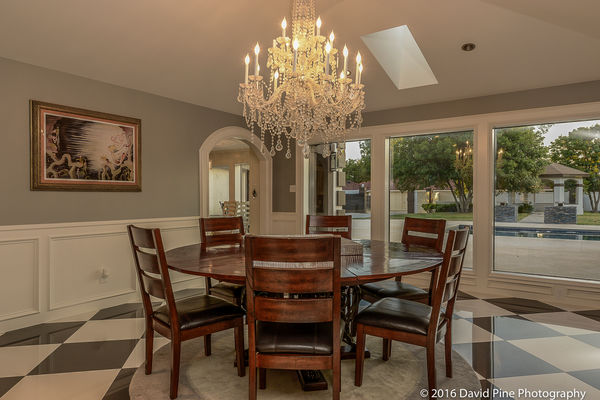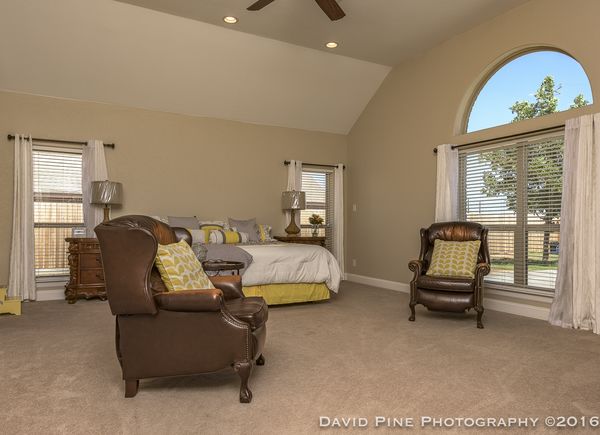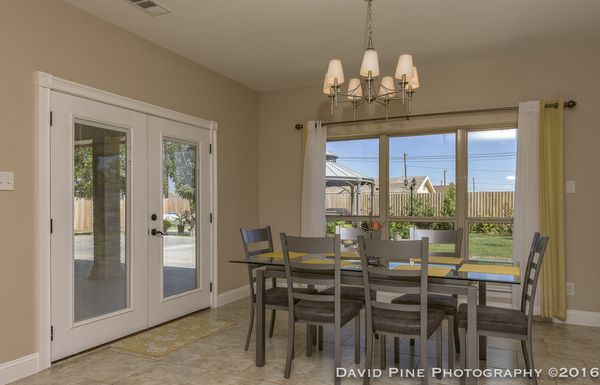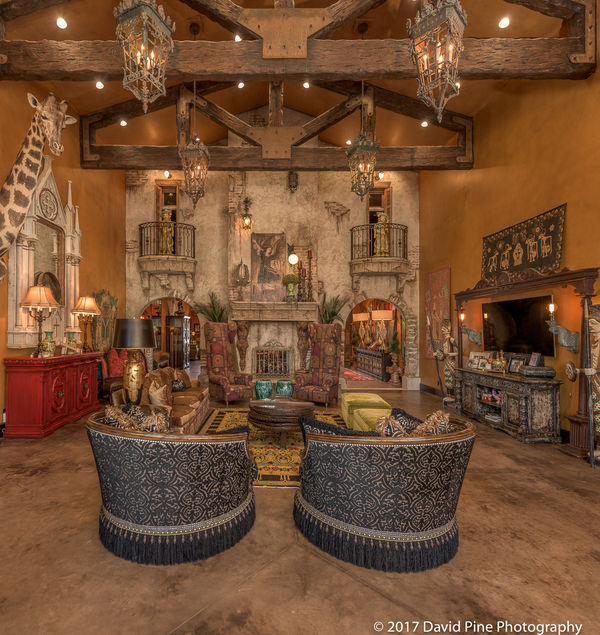Real estate photography
May 4, 2017 08:12:20 #
DavidPine
Loc: Fredericksburg, TX
I am a full time real estate photographer. Some RE photographers bracket 5 to 9 images and process HDR. I don't. Some expose for the window or brightest object and make a second image for the remainder and then blend via masking in PSCC. I use lights because I don't like "blown out" windows. Typically, I set my camera up to shoot manually, ISO 320-400. f/7.1 to f/11. I expose for the window which often calls for a shutter speed of 160 to 250. Then I bounce one or more mono lights to capture the remainder of the room. You need to practice to see what floats your boat. If your shooting for a designer your will mostly be focused on an object and you will probably want to blow out the windows to keep from detracting from the subject. Real Estate photography is different in that you are making documentary images and as far as I'm concerned you show everything within your composition – good or bad – to avoid deception. I am in the minority regarding this issue. I don't green up grass, swap skies or erase the uglies.
canon Lee wrote:
How do you shoot interiors with large bright windows ( real estate photography)?
May 4, 2017 08:15:28 #
romanticf16
Loc: Commerce Twp, MI
Gene51 wrote:
Two exposures - one for the window and one for the... (show quote)
"in the old days" Roscoe Gells were used to cover the windows to match daylight to interior tungsten lighting too!
May 4, 2017 08:34:01 #
The photos from DavidPine are almost perfect in my estimation. The technique has worked perfectly and displayed the room very well.
I's like to have seen the camera raised up higher to take the second shot???????
Nicely done photos and a technique that works - thanks for sharing.
I's like to have seen the camera raised up higher to take the second shot???????
Nicely done photos and a technique that works - thanks for sharing.
May 4, 2017 09:06:02 #
DavidPine
Loc: Fredericksburg, TX
Thank you. I've fortunately made thousands of images. Sometimes I play with the camera height just to keep from going crazier. Sometimes I use a tilt-shift 19mm and 24mm but mostly I use a 14-24. I use 5 mono lights and 8 speed lights and sometimes I even use ambient only. Light changes from room to room and from property to property. It's hard to set anything in stone.
May 4, 2017 09:12:12 #
DavidPine
Loc: Fredericksburg, TX
This image was more difficult than a window shot.
canon Lee wrote:
How do you shoot interiors with large bright windows ( real estate photography)?
May 4, 2017 09:46:56 #
canon Lee wrote:
How do you shoot interiors with large bright windows ( real estate photography)?
canon Lee,
One approach that works well for interior scenes with an outside window is to use a combination of external flash (ETTL) and camera exposure compensation.
You can sync the flash to the camera, then set the camera exposure compensation to a - value for the window light. When the flash fires it exposes the room for the required light, the camera shutter exposes for the window light. Canon bodies have this feature with their compatible flash units. There is a rear button on your Canon body with a "*" to lock the exposure for the shutter.
Michael G
May 4, 2017 10:15:36 #
canon Lee wrote:
How do you shoot interiors with large bright windows ( real estate photography)?
Try to shoot the room at the time of day the sun is on the opposite side of the house. In this case it is a north window, but this is all natural light. Yes the window is a little washed out, but it looks natural.
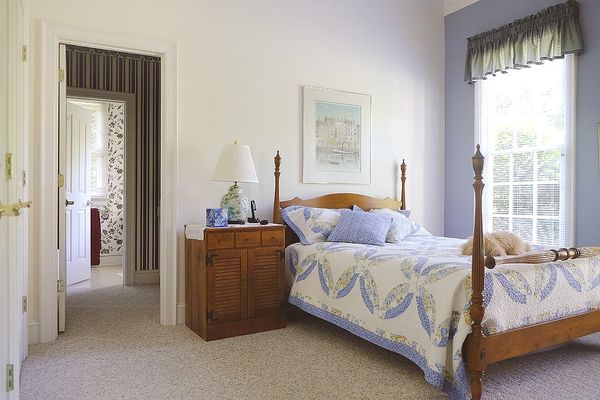
May 4, 2017 10:24:32 #
Great shots. I was looking at a Zillow ad for a neighbor's house and they really could have used this knowledge. Do not know who took their pictures but the main rooms (living room and master bedroom) we shot in the afternoon with west exposure windows. Turned out terrible.
May 4, 2017 10:28:47 #
fetzler
Loc: North West PA
The advice to use HDR or flashes is good. The second problem is the color temperature match between the window and the room. You could use daylight light bulbs or flash as a the primary light source. CTO (color temperature Orange) film can be placed on the windows ( from the outside is best) so that the temperature is matched between outside and inside. If you work during the golden hour (morning or night) the color temperature match will be a bit better. A 48" x 25 ft roll of CTO film is about $125 - 135. It would appear that the clients in the house pictured can afford this.
May 4, 2017 10:54:27 #
bpulv
Loc: Buena Park, CA
In the film days we covered the outside of the windows with the correct neutral density filter film, which came on wide rolls. You only had to worry about the exposure for the interiour and double exposures or compositing of multiple exposures were not required.
May 4, 2017 11:02:01 #
Bear2
Loc: Southeast,, MI
DavidPine wrote:
I am a full time real estate photographer. Some RE... (show quote)
All beautiful David.
Duane
May 4, 2017 11:21:51 #
There have been lots of great ideas by the usual cast of characters and I would agree with all. I find that I have two types of RE shoots. The first is where the realtor is shooting an average house and wants to pay an average cost. For those, I do my best and usually use HDR to solve lighting problems as I need to keep it quick to make a profit, but not so quick that anyone could do it. On the other end are the expensive homes with high end realtors who expect the best and are willing to pay a fair price to get it as most of these costs are passed on to the seller. In each case I make an attempt to produce quality work that I can be proud of. I use various techniques including HDR, panoramas, wide lenses, tilt-shift etc. but I try to be sure that my photos provide an accurate perspective on the home. On the higher end jobs there is almost assuredly a home stylist along for the ride and scheduling to accommodate daylight is most often done. Best of luck.
May 4, 2017 11:38:52 #
DavidPine wrote:
I am a full time real estate photographer. Some RE... (show quote)
Your work is awesome. However I don't shoot for designers but real estate agents that are looking for high quality at a low price and in a minimum of time on site.
May 4, 2017 11:41:59 #
Gene51 wrote:
You may want to take a look at Ron Nachtwey's work... (show quote)
I'm sure you taught him everything he knows and made him what he is today.
May 4, 2017 11:42:44 #
Armadillo wrote:
canon Lee, br br One approach that works well for... (show quote)
Michael I will try your back button technique. Ill get back to you on that after I experimented with it. sounds like a great solution.
If you want to reply, then register here. Registration is free and your account is created instantly, so you can post right away.
